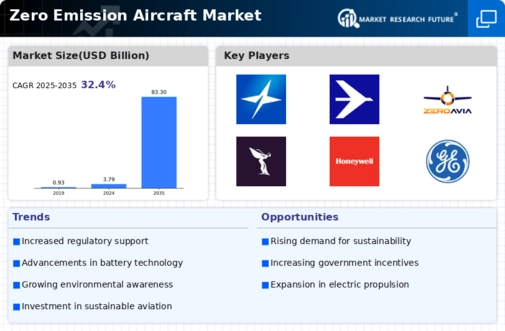Rising Fuel Costs and Economic Viability
Rising fuel costs are driving the need for more economically viable solutions in the aviation sector, thereby influencing the Zero Emission Aircraft Market. As traditional fuel prices fluctuate, airlines are increasingly looking for alternatives that can provide long-term cost savings. Zero-emission aircraft, which utilize electricity or hydrogen as fuel, present a potential solution to mitigate fuel expenses. The operational costs associated with electric aircraft are projected to be significantly lower than those of conventional jets, particularly as battery technology continues to improve. This economic incentive is likely to attract investment and interest in the Zero Emission Aircraft Market, as airlines seek to enhance profitability while adhering to environmental standards.
Environmental Concerns and Sustainability
The increasing awareness of environmental issues is a primary driver for the Zero Emission Aircraft Market. As climate change becomes a pressing concern, stakeholders are seeking sustainable alternatives to traditional aviation. The aviation sector is responsible for approximately 2-3 percent of global carbon emissions, prompting regulatory bodies to impose stricter emissions targets. This has led to a surge in demand for zero-emission aircraft, which promise to significantly reduce the carbon footprint of air travel. Furthermore, consumers are increasingly favoring eco-friendly travel options, which further propels the market. The Zero Emission Aircraft Market is thus positioned to benefit from this shift towards sustainability, as manufacturers innovate to meet the growing expectations of environmentally conscious travelers.
Government Policies and Funding Initiatives
Government policies and funding initiatives play a pivotal role in shaping the Zero Emission Aircraft Market. Many governments are implementing policies aimed at reducing greenhouse gas emissions, which include substantial investments in research and development for zero-emission technologies. For example, funding programs have been established to support the development of hydrogen fuel cells and electric propulsion systems. These initiatives not only provide financial backing but also create a favorable regulatory environment for manufacturers. The Zero Emission Aircraft Market is likely to see accelerated growth as these policies encourage innovation and collaboration among industry players, ultimately leading to the commercialization of zero-emission aircraft.
Technological Advancements in Energy Storage
Technological advancements in energy storage systems are crucial for the Zero Emission Aircraft Market. Innovations in battery technology, such as solid-state batteries and advanced lithium-ion systems, are enhancing the efficiency and range of electric aircraft. For instance, the energy density of batteries has improved significantly, allowing for longer flight durations and heavier payloads. This is particularly important as the industry aims to compete with conventional aircraft. The market for energy storage in aviation is projected to grow, with estimates suggesting a compound annual growth rate of over 20 percent in the coming years. As these technologies mature, they will likely enable the widespread adoption of zero-emission aircraft, transforming the aviation landscape.
Consumer Demand for Sustainable Travel Options
Consumer demand for sustainable travel options is a significant driver for the Zero Emission Aircraft Market. As travelers become more environmentally conscious, there is a growing preference for airlines that prioritize sustainability. Surveys indicate that a substantial percentage of passengers are willing to pay a premium for eco-friendly travel experiences. This shift in consumer behavior is prompting airlines to explore zero-emission aircraft as a means to meet customer expectations. The Zero Emission Aircraft Market stands to gain from this trend, as manufacturers develop aircraft that align with the values of modern travelers. The increasing emphasis on sustainability in travel is likely to shape the future of aviation, making zero-emission solutions more attractive to both consumers and airlines.
























Leave a Comment